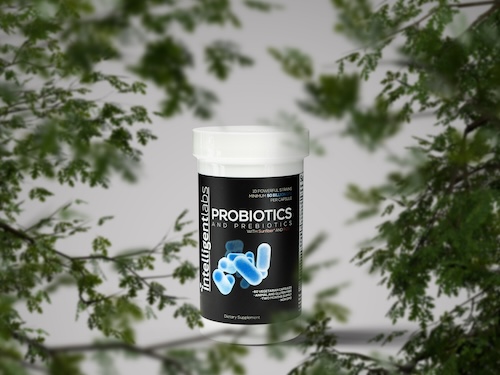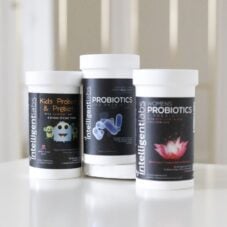Probiotics
How to Pick a Probiotic: 7 Key Factors to Consider
With so many probiotic options out there, finding the right one can be overwhelming. The right probiotic can support gut health, digestion, and immunity,1 but the wrong one may leave you bloated and wasting money. So, how do you pick a probiotic that works? Here are 7 key factors to consider.
Table of Contents
1. CFU Count: The strength in numbers
One of the first things to look for when choosing a probiotic is its colony-forming units (CFUs). This number tells you how many live, active bacteria are in each serving. But not all brands make this easy to spot. Some companies require multiple capsules per serving, so always check the label closely to see how much you’re really getting per capsule.
Typically, you want probiotics that have billions of CFUs per serving. 2 But strength alone isn’t enough. It’s also important to look at the types of bacteria (called strains) that are included.
2. CFUs per Strain: More than just a high count
While a high CFU count is important, you also need to look at how many CFUs each bacterial strain has.

Probiotics work by repopulating your gut with beneficial bacteria, but if the strength per strain is too low, the bacteria won’t be able to thrive in your gut.
For example, if a probiotic contains 10 different strains, you want each strain to have at least 5 billion CFUs to ensure that they’re effective. So, for a 10-strain supplement, a total CFU count of around 50 billion is a good benchmark (this is the CFU count on our Adult Probiotics). This ensures that every strain is strong enough to make a real difference in your gut.
Studies have shown that maintaining a diverse and well-populated gut flora is essential for health. 3 4 Probiotics with insufficient CFUs per strain won’t be able to accomplish that.
3. Patented Strains: Why do they matter?
Probiotics aren’t all the same. Patented probiotic strains come with a wealth of research backing their effectiveness, meaning you know exactly what benefits they provide. Otherwise, they’re more likely to be cheap, generic bacteria that may not offer the benefits you’re hoping for. 5
So, how can you tell if a probiotic contains patented strains?
Look for a number after the strain’s name. For instance, the bacteria Lactobacillus acidophilus is a common probiotic strain, but it’s only when you see something like Lactobacillus acidophilus La-14 that you know you’re dealing with a patented strain.
That said, the strains we use for our probiotics supplements are chosen for their ability to resist stomach acid and bile, so they can pass through your digestive system and reach the intestines, where they do the real work. Without these qualities, the bacteria may die before they can do any good.
4. Enteric coating or delayed-release capsules
Even if you’ve found a probiotic with a high CFU count and patented strains, you need to make sure the bacteria can survive the trip to your gut. Enteric-coated or delayed-release capsules are designed to protect the probiotics from your stomach acid, ensuring they make it to your intestines intact. 6
Without this coating, the bacteria may dissolve in your stomach and never reach the intestines where they’re most needed. Enteric or delayed-release capsules act as an extra layer of protection, increasing the chances that the probiotics survive the journey.
5. Shelf Stability: No refrigeration needed
Many probiotics on the market require refrigeration, but that could actually be a sign of lower-quality strains. High-quality probiotics are shelf-stable, meaning they don’t need refrigeration to stay effective.
One of the big issues with probiotics that require refrigeration is that when they leave their manufacturing facility they won’t be refrigerated during transportation, and during the time they spend hanging around in warehouses.
This time period can be anywhere from a few weeks to a few months. During that time, their strength will be constantly weakening as the bacteria die off, and consequently, they will be far less effective.

6. Prebiotics: Fuel for probiotics
When picking a probiotic, don’t forget to check if it contains prebiotics. Check the ingredient list for common prebiotics like guar fiber or fructooligosaccharides (FOS).
Prebiotics are essentially food for probiotics. The prebiotics ensure that the probiotics are nourished when they are in the capsule, so they are still alive when you take them. They also help to feed the probiotics once they are in your gut.
Without prebiotics, the probiotics may struggle to survive long enough to be effective. A probiotic supplement that includes both prebiotics and probiotics is often referred to as a “synbiotic” and provides a powerful one-two punch for gut health. 7
7. Third-party testing for quality assurance
How can you be sure you’re getting what’s promised on the label? Look for probiotics that undergo third-party testing. Independent testing ensures that the product contains the strains and CFU counts advertised, and that the bacteria are alive and viable.
A study found that many commercial probiotics didn’t contain all the promised strains, and some even had harmful bacteria! Out of 890 isolated bacteria strains, less than half met the criteria for probiotics, with only 420 strains qualifying. 8
If you’re investing in a probiotic for your health, make sure the company is transparent about its testing process. This step helps ensure you’re getting the potency and strains you’re paying for.
Final thoughts on how to pick a probiotic
Picking the right probiotic doesn’t have to be complicated, but it’s important to know what to look for. By focusing on CFU count, patented strains, shelf stability, prebiotics, and third-party testing, you can feel confident that you’re choosing a probiotic that will work for you.
If you’re looking for a probiotic that checks all these boxes, explore our range of Adult Probiotics and Prebiotics, Women’s Probiotics, and Kids Probiotics.
💬 Something on your mind? Share your thoughts in the comments. We love hearing from curious minds.
📩 And while you’re here, join our newsletter for more smart stuff (and secret perks)!
References:
- National Institutes of Health. “Probiotics.” Nih.gov, 3 Nov. 2023, ods.od.nih.gov/factsheets/Probiotics-HealthProfessional/. ↩︎
- Kechagia, Maria, et al. “Health Benefits of Probiotics: A Review.” ISRN Nutrition, vol. 2013, no. 1, 2 Jan. 2013, pp. 1–7, https://doi.org/10.5402/2013/481651. ↩︎
- Lozupone, Catherine A., et al. “Diversity, Stability and Resilience of the Human Gut Microbiota.” Nature, vol. 489, no. 7415, 13 Sept. 2012, pp. 220–230, https://doi.org/10.1038/nature11550. ↩︎
- Hills, Ronald D., et al. “Gut Microbiome: Profound Implications for Diet and Disease.” Nutrients, vol. 11, no. 7, 16 July 2019, p. 1613, https://doi.org/10.3390/nu11071613. ↩︎
- Fijan, Sabina. “Microorganisms with Claimed Probiotic Properties: An Overview of Recent Literature.” International Journal of Environmental Research and Public Health, vol. 11, no. 5, 5 May 2014, pp. 4745–4767, https://doi.org/10.3390/ijerph110504745. ↩︎
- Govender, Mershen, et al. “A Review of the Advancements in Probiotic Delivery: Conventional vs. Non-Conventional Formulations for Intestinal Flora Supplementation.” AAPS PharmSciTech, vol. 15, no. 1, 25 Sept. 2013, pp. 29–43, https://doi.org/10.1208/s12249-013-0027-1. ↩︎
- Pandey, Kavita. R., et al. “Probiotics, Prebiotics and Synbiotics- a Review.” Journal of Food Science and Technology, vol. 52, no. 12, 22 July 2015, pp. 7577–7587, https://doi.org/10.1007/s13197-015-1921-1. ↩︎
- Marinova, Viktoria Yonkova, et al. “Microbiological Quality of Probiotic Dietary Supplements.” Biotechnology & Biotechnological Equipment, vol. 33, no. 1, 1 Jan. 2019, pp. 834–841, https://doi.org/10.1080/13102818.2019.1621208. ↩︎





